Tanzania Biodiversity: Animal and Plant Species and What Is Under Threat
Did you know that Tanzania is home to over 14,500 known and confirmed species of animals and plants? This East African country, known for its iconic wildlife and stunning landscapes, boasts a remarkable biodiversity that includes a high number of endemic and threatened species. With six out of the 25 globally recognized biodiversity hotspots located within its borders, Tanzania plays a crucial role in conserving the rich flora and fauna of Africa.
Key Takeaways:
- Tanzania is a mega-biodiversity rich country, hosting six out of the 25 globally known biodiversity hotspots.
- The country is home to over 14,500 known and confirmed species, including a high number of endemic and threatened species.
- Tanzania accounts for more than one-third of the total plant species in Africa and is twelfth globally in terms of bird species.
- The biodiversity in Tanzania is currently facing numerous threats, including habitat loss, poaching, and unsustainable resource management.
- Efforts are being made to protect and conserve Tanzania’s biodiversity, but challenges remain in terms of weak institutions and competing land uses.
Key Policies and Governance Approach
In Tanzania, biodiversity conservation is coordinated by the Vice President’s Office, Division of the Environment (VPO-DoE). This division is responsible for enforcing the implementation of various strategies, guidelines, policies, and legislation aimed at preserving Tanzania’s rich biodiversity. The country has made significant progress in expanding protected land, with the total area increasing by over 20% between 1995 and 2014.
Tanzania boasts a diverse network of protected areas, including national parks, biosphere reserves, game reserves, wildlife management areas, forests, marine parks, and Ramsar Sites. These designated areas play a crucial role in safeguarding Tanzania’s flora and fauna, ensuring their long-term survival and contributing to the country’s conservation efforts.
Key legislation governing biodiversity conservation in Tanzania includes the Environmental Management Act, Wildlife Conservation Act, and wildlife management area regulations. These laws provide a framework for managing and protecting the country’s natural resources, while also addressing issues such as sustainable land use and wildlife conservation.
Several institutions play a vital role in ensuring the effective implementation of biodiversity conservation policies in Tanzania. The National Environment Management Council (NEMC) is responsible for regulating and coordinating environmental management activities. It works closely with other government agencies, NGOs, and local communities to promote sustainable practices and protect Tanzania’s natural ecosystems.
Wildlife management support units also contribute to Tanzania’s governance approach by providing technical expertise, conducting research, and supporting conservation efforts on the ground. These units work in collaboration with various stakeholders to monitor and manage wildlife populations, protect habitats, and mitigate human-wildlife conflicts.
“The effective governance approach in Tanzania ensures the sustainable management of biodiversity and promotes the coexistence of humans and wildlife.”
| Type of Protected Area | Number | Total Area (sq km) |
|---|---|---|
| National Parks | 17 | 52,300 |
| Biosphere Reserves | 4 | 5,016 |
| Game Reserves | 43 | 73,002 |
| Wildlife Management Areas | 40 | 162,894 |
| Forests | 34 | 81,523 |
| Marine Parks | 7 | 3,293 |
| Ramsar Sites | 8 | N/A |
The table above highlights the different types of protected areas in Tanzania and their respective numbers and total land areas. These protected areas serve as crucial conservation spaces, ensuring the preservation of Tanzania’s unique biodiversity.
Successes and Remaining Challenges
While Tanzania has implemented sound policies related to natural resource management, the implementation at the ground level is hindered by poor quality data, inadequate analysis, and weak institutional capacity. Unsustainable and inefficient resource management practices, such as overexploitation of forests for firewood, have led to overexploitation of resources by local communities. Weak institutions are also contributing to the escalation in poaching, posing a threat to ecosystems and the tourism industry. Challenges identified include coordination between different agencies, inadequate capacity for planning and enforcement, insufficient stakeholder involvement, and inadequate incentives for sustainable resource management.
“Conservation efforts in Tanzania are facing significant challenges due to weak institutions and unsustainable resource management practices. Coordination between different agencies needs to be improved, and there is a pressing need for better planning and enforcement. In addition, stakeholder involvement and incentives for sustainable resource management must be prioritized,” said Dr. Jane Owen, a wildlife conservation expert.
One of the major challenges in Tanzania is the weak institutional capacity to effectively implement conservation policies and initiatives. The lack of well-trained personnel in key government agencies responsible for natural resource management hampers their ability to enforce regulations and address conservation issues adequately. This results in ineffective monitoring and enforcement, allowing for illegal activities such as poaching and unsustainable resource exploitation to persist.
Poaching remains a significant threat to Tanzania’s biodiversity. The country is home to a wide range of iconic species, including elephants, rhinoceroses, and big cats, which are targeted by poachers for their ivory, horns, and skins. Weak law enforcement, corruption, and the presence of international criminal networks exacerbate the problem, making it difficult to combat poaching effectively.
Another challenge is the unsustainable use of natural resources, particularly the overexploitation of forests for firewood. Many rural communities heavily rely on forests for energy, leading to deforestation and habitat loss. This not only impacts the biodiversity within forests but also disrupts the delicate balance of ecosystems, contributing to the decline of certain species and the overall degradation of Tanzania’s natural landscapes.
To address these challenges, Tanzania needs to strengthen its institutions and increase their capacity to enforce conservation regulations. This includes investing in training programs for conservation professionals, improving the collection and analysis of data, and enhancing coordination between different agencies and stakeholders. Incentives for sustainable resource management should also be introduced to encourage local communities to adopt more environmentally friendly practices.
Image:

Initiatives and Development Plans
Tanzania is committed to implementing various initiatives and development plans to ensure the conservation of its rich biodiversity and promote sustainable development. The country has taken significant steps, including signing and ratifying the Convention on Biological Diversity, to protect and preserve its natural resources.
“Conservation is not merely a luxury for a prosperous society, but an absolute necessity for sustainable development and the well-being of all people.” – Jakaya Kikwete
One of the key measures implemented by Tanzania is the development and implementation of national biodiversity strategies and action plans. These comprehensive plans outline the strategies and actions needed to address the unique biodiversity challenges faced by the country. They also focus on addressing issues such as climate change, land degradation, and the conservation of marine and coastal environments.
Tanzania has established institutions and agencies dedicated to biodiversity management, research, and monitoring of forest resources. These organizations play a crucial role in implementing conservation initiatives and ensuring the sustainable use of natural resources.
Furthermore, Tanzania actively participates in regional and international agreements on biodiversity conservation. By collaborating with other nations, Tanzania aims to achieve a collective effort in protecting and conserving biodiversity on a global scale.
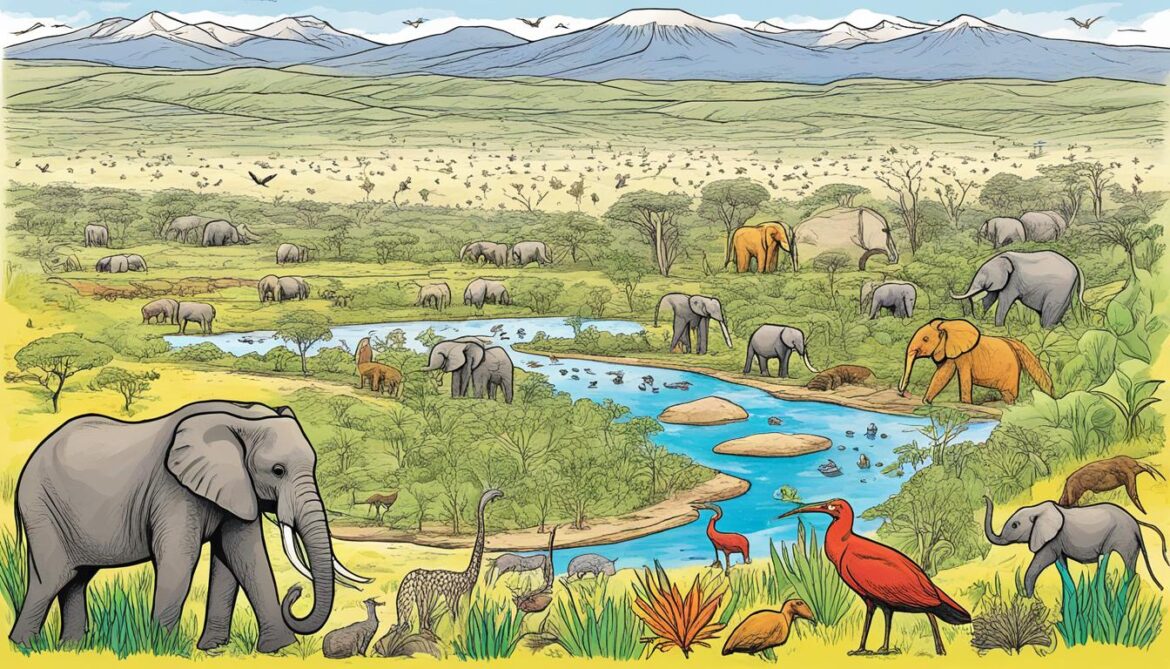
Additionally, the World Bank has supported various initiatives in Tanzania related to biodiversity conservation. These initiatives focus on reducing illegal fishing practices, restoring fisheries, and improving livelihoods in local communities. By addressing these issues, the country aims to promote sustainable practices that benefit both the environment and the people.
Through these initiatives and development plans, Tanzania strives to ensure the long-term conservation of its biodiversity while promoting sustainable development for the benefit of current and future generations.
Goals and Ambitions
Tanzania is committed to the preservation and sustainable management of its rich biodiversity. In line with this goal, the country has set forth several ambitious objectives:
- Establish new marine protected areas: Tanzania aims to create marine protected areas in biodiversity hotspots, safeguarding vulnerable ecosystems and marine species.
- Expand wildlife management areas and forest nature reserves: By expanding these areas, Tanzania seeks to create improved wildlife corridors, allowing for better movement and interaction among animal populations.
- Promote new protected areas: The country aims to add new protected areas to its already extensive network, ensuring the conservation of key habitats and species.
- Review policies and strategies for managing protected areas: Tanzania plans to evaluate existing policies and strategies to ensure their effectiveness in preserving biodiversity.
- Strengthen measures to limit illegal exploitation of resources: By enhancing enforcement efforts, Tanzania aims to combat illegal activities that endanger its biodiversity.
- Promote regional cooperation on protected areas: Collaboration with neighboring countries will facilitate a cross-border approach to biodiversity conservation.
- Enhance the ecosystem approach in protected areas: Tanzania recognizes the importance of ecosystem-based management, which considers the interdependencies of species and habitats.
- Improve capacity for the management of protected areas: The country aims to enhance the skills and resources necessary for effective management of both terrestrial and marine protected areas.
Tanzania also places great emphasis on sustainable resource management, stakeholder involvement, and institutional capacity-building to ensure the long-term success of its conservation efforts.
| Conservation Goals | Status |
|---|---|
| New marine protected areas | In progress |
| Expansion of wildlife management areas and forest nature reserves | Ongoing |
| Promotion of new protected areas | Underway |
| Review of policies and strategies for managing protected areas | Upcoming |
| Strengthent measures to limit illegal exploitation of resources | Implemented |
| Promotion of regional cooperation on protected areas | In progress |
| Enhancement of ecosystem approach in protected areas | Ongoing |
| Improvement of capacity for management | Planned |
Biodiversity Facts
Biodiversity in Tanzania showcases a remarkable range of genetic diversity, species diversity, and ecosystem diversity. The country is renowned for its abundant genetic diversity within species, boasting distinctive populations with unique genes. Tanzania also exhibits impressive species diversity, with a wide variety of species found in different regions across the country. Furthermore, Tanzania features a diverse array of interconnected ecosystems, including lush forests, pristine lakes, winding rivers, and expansive grassland savannas.
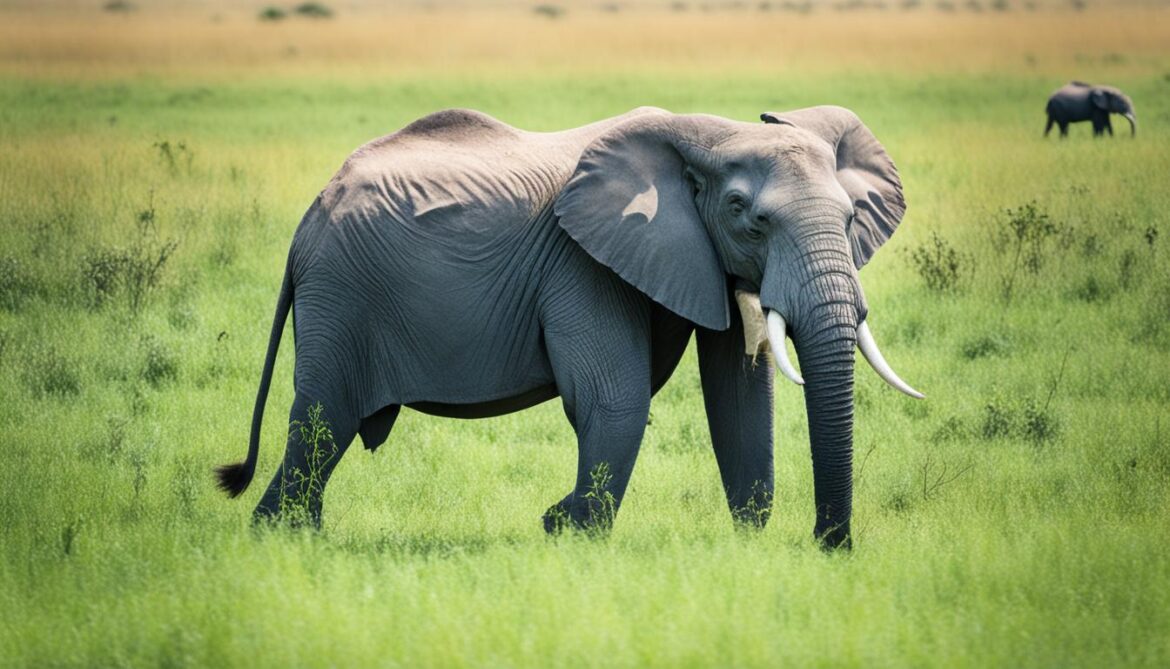
Genetic Diversity
“Tanzania’s genetic diversity within species is truly remarkable, with distinct populations possessing unique genes.”
Species Diversity
The breathtaking diversity of species in Tanzania showcases the country’s natural wealth and ecological abundance. From majestic mammals to vibrant birds, Tanzania is home to a vast range of species that inhabit its diverse landscapes. Each region within Tanzania harbors its own distinct assortment of flora and fauna, contributing to the country’s rich species diversity.
Ecosystem Diversity
“Tanzania’s ecosystems are as diverse as they are magnificent, with forests, lakes, rivers, and grassland savannas forming interconnected habitats.”
| Ecosystem Types | Examples |
|---|---|
| Forests | Eastern Arc Mountains, Udzungwa Mountains, coastal forests |
| Lakes | Lake Victoria, Lake Tanganyika, Lake Nyasa |
| Rivers | Nile River, Rufiji River, Pangani River |
| Grassland Savannas | Serengeti National Park, Ngorongoro Conservation Area, Selous Game Reserve |
Importance of Biodiversity
Biodiversity plays a crucial role in the national economy of Tanzania. It contributes significantly to the GDP, employment, and export earnings of the country. Industries such as agriculture, livestock, forestry, and fisheries heavily rely on the diverse range of plant and animal species found in Tanzania. The forests in Tanzania provide the majority of energy consumption, while hydropower contributes to the power supply.
Tourism, largely driven by Tanzania’s rich biodiversity, is a significant contributor to the GDP. The country is known for its stunning landscapes, iconic wildlife, and diverse ecosystems. Tourists from around the world visit Tanzania to experience its renowned national parks, such as the Serengeti and Ngorongoro Crater, as well as its breathtaking coastlines and marine life. The tourism industry creates employment opportunities and generates revenue for local communities, contributing to poverty alleviation and sustainable development.
Biodiversity in Tanzania also supports essential ecosystem services that are crucial for human well-being. For example, forests play a vital role in electricity production through hydropower, while wetlands help with groundwater recharge and act as natural buffers for flood control. Ecosystems also provide water retention, pollination, and climate regulation services, which are crucial for sustainable agriculture and food security.
Tanzania’s rich biodiversity is not only a natural treasure but also a driver of economic growth, employment, and crucial ecosystem services.
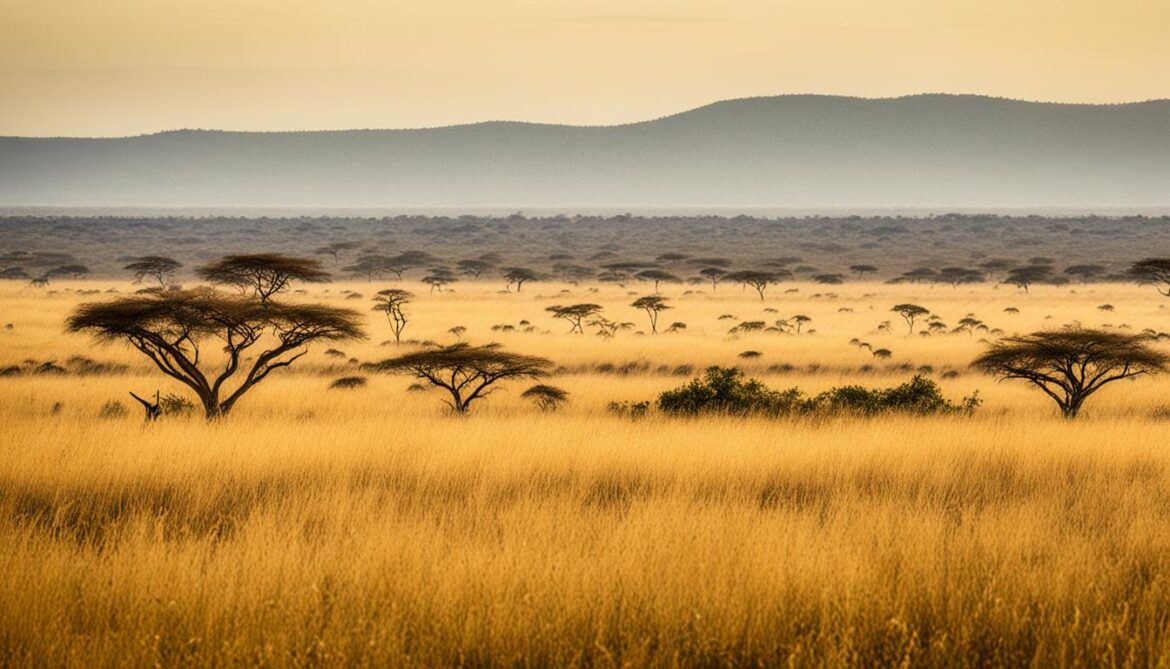
| Economic Contribution | Ecosystem Services |
|---|---|
|
|
Status and Trends
The overall trends of biodiversity in Tanzania are a cause for concern. Many ecosystems in the country are showing signs of deterioration, and a significant number of species are facing decline. Despite designating a substantial portion of its surface area as protected or conserved, Tanzania still faces challenges in ensuring the survival of wildlife outside these areas.
There are several globally endangered and threatened species in Tanzania, including the black rhinoceros, wild dog, chimpanzee, African elephant, cheetah, and wattled crane. Their declining populations highlight the urgent need for conservation efforts to protect their habitats and promote their recovery.
Additionally, Tanzania is experiencing the degradation of wetlands, the decline of mangroves, and increasing competition for land resources, which further contribute to the declining status of biodiversity in the country.
“The health of ecosystems is essential for the survival of numerous species. Protecting and conserving biodiversity in Tanzania is crucial to maintain ecological balance and secure the future of our natural heritage.”
To better understand the status and trends of biodiversity in Tanzania, let’s take a look at the table below, which highlights the population status and conservation status of some endangered species:
| Species | Population Status | Conservation Status |
|---|---|---|
| Black Rhinoceros | Critically endangered | Endangered (IUCN) |
| Wild Dog | Endangered | Endangered (IUCN) |
| Chimpanzee | Endangered | Endangered (IUCN) |
| African Elephant | Vulnerable | Vulnerable (IUCN) |
| Cheetah | Vulnerable | Vulnerable (IUCN) |
| Wattled Crane | Endangered | Endangered (IUCN) |
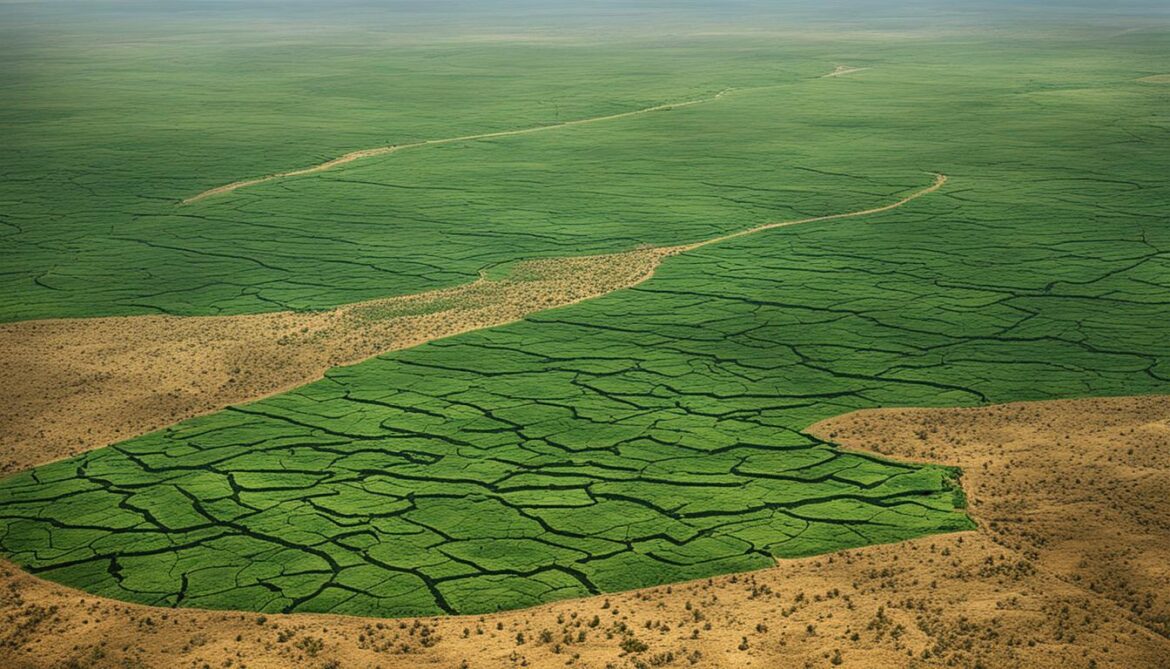
As seen in the table and illustrated in the image above, wildlife populations are under significant threat. Immediate action is required to mitigate the decline and ensure the preservation of Tanzania’s invaluable biodiversity.
Main Pressures and Drivers of Change
The conservation of biodiversity in Tanzania faces several significant pressures and drivers of change. These factors pose threats to the delicate balance of ecosystems and the rich biodiversity of the country. Understanding these pressures is crucial for implementing effective conservation strategies and safeguarding Tanzania’s natural heritage.
Overgrazing and Resource Overexploitation
One of the primary threats to biodiversity in Tanzania is overgrazing. As a result of population growth and livelihood needs, there is intense pressure on natural grasslands and vegetation. Livestock grazing exceeds the carrying capacity of ecosystems, leading to habitat degradation and the displacement of native plant species. This contributes to a loss of habitat for wildlife and threatens the survival of many species.
Resource overexploitation is another major driver of biodiversity loss in Tanzania. Unsustainable harvesting of timber, non-timber forest products, and other natural resources puts immense pressure on ecosystems. Forests are depleted for fuelwood and construction materials, leading to habitat destruction and soil erosion. The exploitation of wildlife for bushmeat and illegal trade further exacerbates the depletion of species and disrupts ecosystem dynamics.
Bushfires and Dependence on Fuelwood
Bushfires pose significant threats to Tanzania’s biodiversity. These fires, often caused by human activities such as clearing land for agriculture or hunting, destroy vast areas of vegetation. They contribute to the loss of habitat and disrupt ecological processes, potentially leading to local extinctions and the alteration of ecosystems.
The dependency on fuelwood for cooking and heating is also a driver of change in Tanzania. As a result of limited access to alternative energy sources, many communities rely heavily on fuelwood, leading to the unsustainable harvesting of trees and shrubs. This not only contributes to deforestation but also impacts the availability of critical habitat for wildlife.
Poverty and Unsustainable Agricultural Practices
Poverty plays a significant role in driving biodiversity loss in Tanzania. Limited access to economic opportunities and resources often forces communities to rely on natural resources for their subsistence. Unsustainable agricultural practices, such as slash-and-burn agriculture and the use of agrochemicals, degrade soil quality and contribute to land degradation. This, in turn, affects the health of ecosystems and reduces the resilience of biodiversity to environmental changes.
Inadequate Information and Awareness
A lack of adequate information on genetic resources and biodiversity conservation hinders effective planning and decision-making in Tanzania. Insufficient data and knowledge about the country’s biodiversity and its ecological importance make it challenging to design targeted conservation strategies. Additionally, a lack of awareness among local communities and stakeholders about the value of biodiversity and the importance of conservation leads to unsustainable practices and increased threats to ecosystems.
Mangrove Over-Harvesting, Destructive Fishing, and Pollution
Tanzania’s coastal and marine ecosystems face multiple pressures, including the over-harvesting of mangroves. Mangroves are vital habitats that support a diverse range of marine life, protect coastlines, and serve as nurseries for various species. The unsustainable cutting of mangroves for timber, fishing, and coastal development disrupts these ecosystems and threatens the survival of many marine species.
Destructive fishing practices, such as dynamite fishing and the use of illegal nets, also pose significant threats to marine biodiversity. These practices result in the indiscriminate capture of marine species, including threatened and endangered species, and damage coral reefs and other marine habitats. Pollution from industrial and domestic sources further degrades marine and coastal ecosystems, threatening the health and survival of marine life.
Shifting Cultivation and Indiscriminate Waste Disposal
Shifting cultivation, commonly practiced in some rural areas of Tanzania, contributes to biodiversity loss and environmental degradation. The clearing of land for temporary crop cultivation disrupts natural habitats and leads to soil erosion. This reduces the availability of suitable habitats for native species and increases vulnerability to invasive species.
Indiscriminate disposal of waste into water bodies, including rivers and lakes, also poses threats to biodiversity. Pollution from untreated sewage, industrial effluents, and solid waste adversely affects aquatic ecosystems and the organisms dependent on them. It disrupts the natural balance of these ecosystems and reduces their capacity to support biodiversity.

In summary, the main pressures and drivers of change for biodiversity in Tanzania include overgrazing, resource overexploitation, bushfires, fuelwood dependency, poverty, unsustainable agricultural practices, inadequate information and awareness, mangrove over-harvesting, destructive fishing practices, pollution, shifting cultivation, and indiscriminate waste disposal. Addressing these challenges requires a holistic and coordinated approach that integrates sustainable development practices, conservation efforts, and community engagement to ensure the long-term preservation of Tanzania’s remarkable biodiversity.
Measures to Enhance Implementation of the Convention
Tanzania has demonstrated its commitment to the conservation and sustainable use of biodiversity through the implementation of various measures. A key initiative in this regard is the National Biodiversity Strategy and Action Plan (NBSAP), developed to guide priority actions in Tanzania’s conservation efforts.
The NBSAP encompasses a wide range of measures that address different aspects of biodiversity conservation. These include the formulation of policy and regulatory frameworks to ensure effective governance and management.
Regional and international cooperation is a crucial component of Tanzania’s approach to biodiversity conservation. By collaborating with other nations and organizations, Tanzania can leverage shared resources, knowledge, and experience for more effective conservation outcomes.
Planning and coordination play a vital role in ensuring the successful implementation of biodiversity conservation measures. By developing comprehensive plans and coordinating with relevant stakeholders, Tanzania can enhance the efficiency and impact of its efforts.
Education and information dissemination are essential for raising awareness and fostering a culture of biodiversity conservation in Tanzania. Through education programs and public awareness campaigns, the country can promote sustainable practices and encourage citizen participation in conservation initiatives.
Research and development form the backbone of evidence-based conservation strategies in Tanzania. By investing in scientific research and technological advancements, the country can gain a deeper understanding of its biodiversity and develop innovative solutions for its protection.
The conservation of ecosystems and species is a fundamental objective of Tanzania’s biodiversity conservation efforts. Through the establishment of protected areas, wildlife corridors, and habitat restoration projects, the country aims to safeguard its unique biodiversity and promote ecological resilience.
Biodiversity monitoring and evaluation are crucial for assessing the effectiveness of conservation measures and identifying areas that require further intervention. By regularly monitoring biodiversity indicators, Tanzania can make informed decisions and adapt its strategies to ensure positive conservation outcomes.
Capacity-building is a key focus area to strengthen Tanzania’s ability to implement biodiversity conservation measures. By providing training, technical support, and resources to individuals and institutions involved in conservation efforts, the country can enhance its overall conservation capacity.
Tanzania has also embraced community-based natural resource management as a means of engaging local communities and ensuring their active participation in conservation. This approach fosters a sense of ownership and responsibility among community members, leading to more sustainable resource management practices.
The establishment of bylaws and commissions dedicated to safeguarding conservation efforts further strengthens Tanzania’s commitment to biodiversity conservation. These mechanisms ensure the enforcement of regulations and provide a structured framework for addressing conservation challenges.
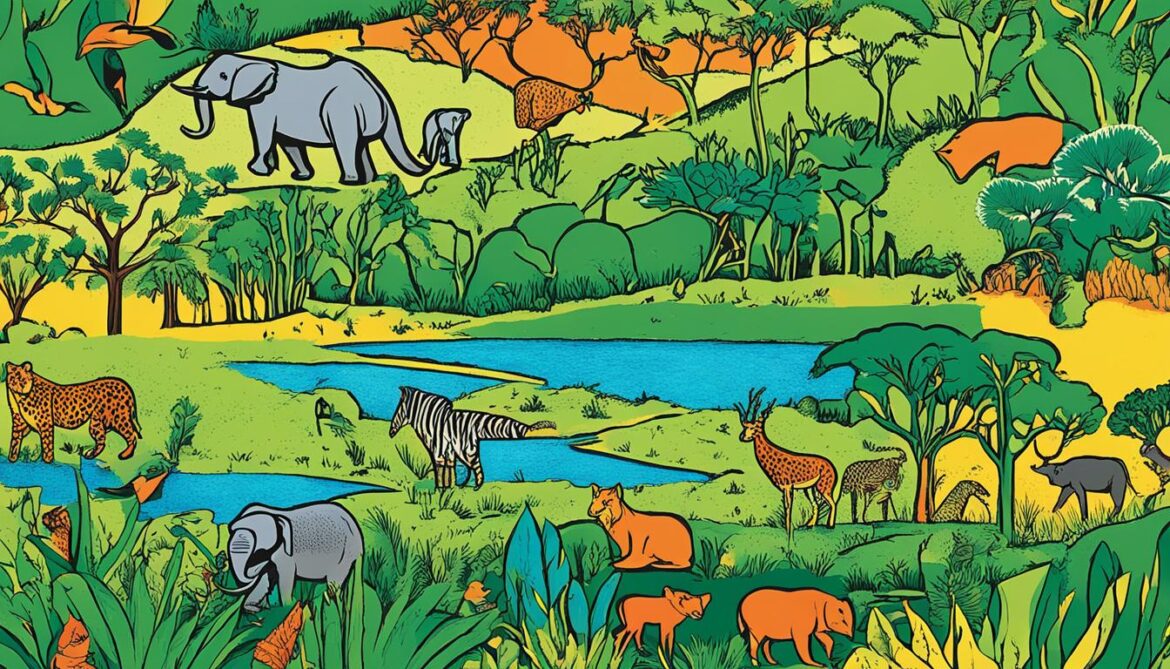
In summary, Tanzania has implemented a comprehensive set of measures to enhance the implementation of the Convention on Biological Diversity. Through the NBSAP and various other initiatives, the country is actively working towards the conservation and sustainable use of its rich biodiversity. By prioritizing policy frameworks, promoting cooperation, investing in research and education, and engaging local communities, Tanzania is taking significant steps towards achieving its conservation goals and ensuring a sustainable future for its unique natural heritage.
Conclusion
Tanzania’s biodiversity is a valuable asset that contributes significantly to the country’s economy, livelihoods, and ecosystem services. Through the implementation of various policies, initiatives, and development plans, Tanzania has made strides in conserving and utilizing its biodiversity in a sustainable manner. However, there are still challenges to overcome, including weak institutions, limited resources, and competing land uses.
In order to achieve its conservation goals and ambitions, Tanzania must address these challenges and prioritize stakeholder involvement and capacity-building efforts. It is crucial to protect and preserve Tanzania’s biodiversity for future generations, as it not only benefits the environment but also supports sustainable development. By striking a balance between conservation efforts and economic growth, Tanzania can ensure the long-term wellbeing of both its people and its natural assets.
Tanzania’s commitment to biodiversity conservation and sustainable development is vital not only for the country but also for the global community. By protecting its unique ecosystems and diverse species, Tanzania plays a crucial role in safeguarding the planet’s overall biodiversity. It is through continued collaboration, innovation, and investment in conservation efforts that Tanzania can secure a sustainable future for its rich biodiversity.








